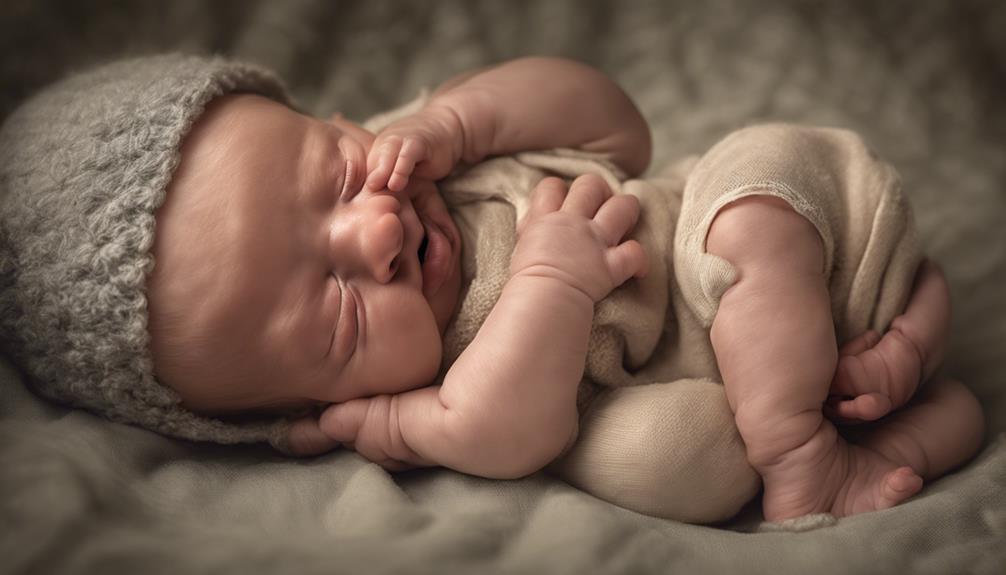Having a newborn at home can sometimes feel like navigating through unfamiliar territory in the middle of the night, searching for the precious treasure of sleep. Picture yourself standing on the edge of a vast ocean, peering into the darkness, pondering how to lead your little one to the shores of tranquil slumber.
But fear not, for within these pages lie the secrets to help your newborn find the rest they need. Let's uncover the hidden gems of sleep wisdom together and discover the path to a well-rested family.
Key Takeaways
- Swaddling techniques mimic the womb for better sleep.
- Recognize baby's sleep cues like yawning and eye rubbing.
- Establish a consistent bedtime routine for healthy sleep habits.
- Create a calm sleep environment with dark, quiet spaces.
Swaddling Techniques for Better Sleep
Swaddling your newborn correctly is essential for promoting better sleep and ensuring their comfort and security. When done right, swaddling mimics the cozy environment of the womb, offering a sense of calm and security to your little one. This technique not only aids in reducing the startle reflex that can disrupt sleep but also helps prevent sleep regression by encouraging longer, more restful sleep periods. By swaddling your baby, you can enhance the quality of their sleep, promoting relaxation and comfort throughout the night.
Establishing a consistent sleep routine through proper swaddling techniques can work wonders in calming your newborn and providing them with a sense of security. The gentle pressure of the swaddle can create a soothing environment, allowing your baby to relax and drift off to sleep peacefully. Remember, a well-swaddled baby is a content baby, ready to embrace the night with comfort and tranquility.
Recognizing Your Baby's Sleep Cues

When your baby displays subtle signs of fatigue like eye rubbing or yawning, it's important to recognize these cues as indicators that they're ready for sleep. Observing your baby's behavior for signs of tiredness, such as fussiness, calmness, or disengagement with their surroundings, can help you understand when it's time for them to rest. Pay close attention to their body language; decreased activity, responsiveness, or glazed eyes are all signals that your baby may be ready to sleep.
Each baby is unique, so recognizing individual sleep cues and patterns is key in establishing a successful sleep routine.
Establishing a Consistent Bedtime Routine

To help your newborn establish healthy sleep habits, creating a consistent bedtime routine is essential. Babies thrive on routine, and a predictable bedtime ritual can signal to your little one that it's time to wind down and prepare for rest. By following a set routine each night, you can help your newborn recognize sleep cues, promoting self-soothing and making it easier for them to fall asleep.
Establishing a bedtime routine not only sets the stage for a calming environment but also plays an important role in improving the quality and duration of your baby's sleep. This regularity aids in maintaining a healthy sleep schedule, ensuring that your newborn gets the rest they need to grow and develop.
Creating a Calm Sleep Environment

For a peaceful and restful sleep experience, it's crucial to create a calming environment conducive to your newborn's slumber. Here are some practical tips to help you establish the perfect sleep setting for your little one:
- Keep the room dark: Darkening the room can help promote better sleep associations and signal nighttime to your baby.
- Use a white noise machine: White noise can mask external sounds and create a soothing environment that helps your baby relax.
- Maintain ideal room temperature: Keep the room between 68-72 degrees Fahrenheit for a comfortable sleep environment.
- Establish a regular sleep routine: Building a consistent bedtime routine can help your baby get into good sleep habits and improve their overall sleep schedule.
Managing Nighttime Diaper Changes
Managing nighttime diaper changes involves gently and efficiently ensuring minimal disruption to your newborn's sleep. When it's time for a diaper change during the night, opt for quick and quiet techniques to maintain a calm environment. Minimize conversion by keeping lights dim and avoiding excessive talking. Choosing absorbent and comfortable diapers can help prevent discomfort, promoting uninterrupted sleep for your little one. Incorporating diaper changes into your bedtime routine signals to your newborn that it's time to settle down for the night, creating a familiar and soothing pattern. By following these gentle practices, you can help your baby shift smoothly through diaper changes without fully waking up, allowing them to drift back into peaceful slumber faster. Remember, the key is to be swift and gentle, aiming to keep the nighttime interruptions as brief and unobtrusive as possible.
| Gentle Techniques | Minimize Stimulation | Comfortable Diapers |
|---|---|---|
| Quick & Quiet | Dim Lights | Absorbent |
| Soft Touch | Soft Voices | Snug Fit |
| Calm Atmosphere | Limited Movement | Skin-Friendly |
Frequently Asked Questions
What to Do When a Newborn Won't Sleep?
When a newborn won't sleep, we prioritize a calming bedtime routine, swaddling for security, white noise or music for soothing, a dark, cozy room, and monitoring for hunger or discomfort. Ensuring these factors helps promote quality sleep.
Why Is My Newborn Fighting Sleep?
We've been there too. Newborns fight sleep for many reasons – hunger, discomfort, or adjusting to this big world. Establishing routines, creating a cozy environment, and being patient can help. Remember, this too shall pass.
What to Do When Newborn Is Overtired and Won T Sleep?
When newborns are overtired and won't sleep, we focus on recognizing signs like fussiness and implement a calming routine. We avoid delaying naps, provide a cozy sleep environment, and maintain consistent schedules to improve sleep patterns.
What to Do When Newborn Wants to Be Held to Sleep?
When our newborn craves being held to sleep, we gently introduce independent sleeping in a cozy space. We establish calming routines and soothing sounds to foster self-soothing. Slowly, our little one learns to find comfort and rest in their own sleep environment.
Can Holding My Newborn Too Much Cause Them to Have Trouble Sleeping?
Some may worry that holding their newborn too much could affect their sleep. However, studies show that cuddling actually promotes better sleep for babies. Remember to follow a guide to better sleep, such as creating a consistent bedtime routine, to help your newborn sleep soundly.
Conclusion
So, are you ready to help your newborn get the sleep they need?
By swaddling them, recognizing their sleep cues, establishing a bedtime routine, creating a calm sleep environment, and managing nighttime diaper changes, you can make a big difference in their sleep patterns.
Remember, consistency is key in building healthy sleep habits for your little one.
You've got this, parents! Let's help our newborns get the rest they deserve.








